“We are very proud. We have just finished an information guide that the National Board of Health and Welfare will distribute to Sweden’s social workers,” Marcus Knutagård tells LUM when we meet him and colleagues Cecilia Heule, Hans Swärd and Arne Kristiansen in the foyer of the School of Social Work.
In 2009, the stars aligned: Marcus Knutagård completed his doctoral studies with a thesis on the causes of homelessness, one of its conclusions was that Housing First is the model most effective in tackling homelessness, Marcus and his colleagues were tasked by the National Board of Health and Welfare with evaluating the national homelessness strategy and the former director general of Vinnova, Per Eriksson, became Vice-Chancellor of Lund University.
“I had been in touch with Per Eriksson about social science innovations while he was at Vinnova,” says Cecilia Heule. He felt that there were far too few of them.”
The Vice-Chancellor influenced politicians
A few years later, their paths crossed again. By then Per Eriksson was Vice-Chancellor in Lund and he had read the evaluation of Swedish homelessness strategy by researchers from the School of Social Work. It was then, according to Cecilia Heule, that he saw his opportunity to help influence politicians and homelessness coordinators within social services. The aim was to reduce homelessness through a well-researched method.
“We had the research, but we weren’t used to following the process forward,” says Professor Emeritus Hans Swärd. Having the Vice-Chancellor weigh in on behalf of our research on homelessness was important. Among many other things, he would contact us before Christmas each year, asking us to write an opinion piece about homelessness.”
As a first step in their advocacy work, the researchers, supported by the Vice-Chancellor, invited politicians, homelessness coordinators, researchers and clients to a conference where they presented the Housing First approach. Interest was awakened, and only around six months later, they organised another. Since then, Marcus Knutagård and Arne Kristiansen in particular have travelled around the country giving lectures on the model.
The model was tried in Helsingborg
A milestone was reached when the director of social services in Helsingborg, Dinah Åbringer, decided to introduce the model on a trial basis. Another breakthrough in the spreading of the model nationwide was when the National Board of Health and Welfare established an expert group including the School of Social Work, Stadsmissionen, the Swedish National Board of Housing, Building and Planning and others.
What progress has been made on the overall aim of ending homelessness?
“Unfortunately, homelessness remains high, and there are still 9,000 homeless children in Sweden,” says Hans Swärd. “Even if more municipalities want to introduce the Housing First model, there are major obstacles. In the past, social workers had a more integrated approach to the needs of those seeking assistance. Nowadays each individual might need to meet with four different caseworkers and the municipalities contract out housing to the lowest bidding providers. This, coupled with the housing shortage, makes it more difficult to meet each individual’s need for a home of their own.”
"A good example of impact"
Despite this, the Housing First researchers have cause for satisfaction. Their efforts have led to more than 600 homeless people obtaining their own tenancies and, in the vast majority of cases, retaining them. Of Sweden’s 290 municipalities, 140 have received funding to actively work with the method.
“Even if we’re not there yet, I think this is an example of the impact research has,” says Arne Kristiansen.



